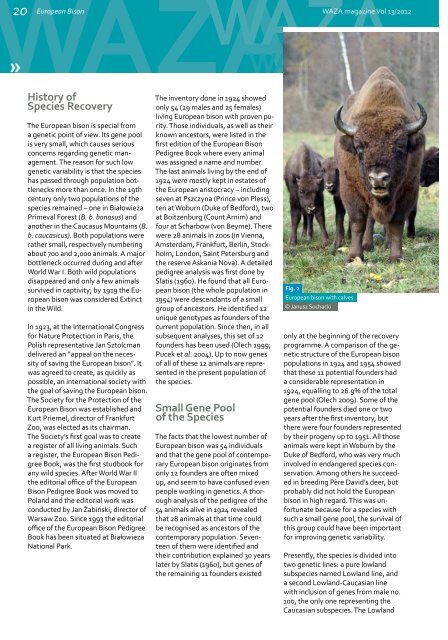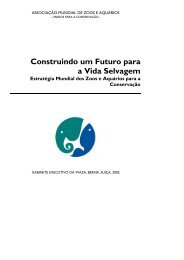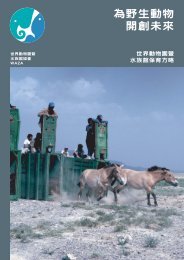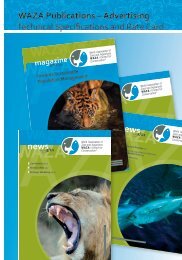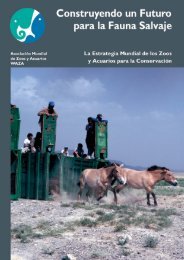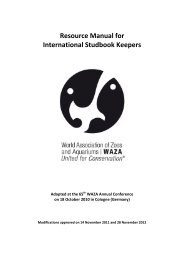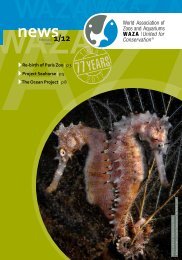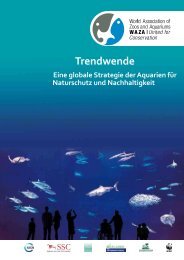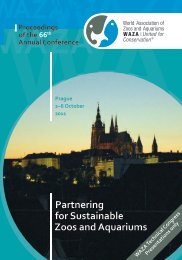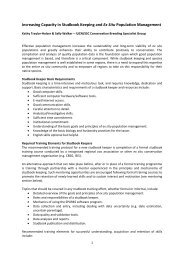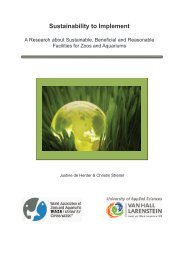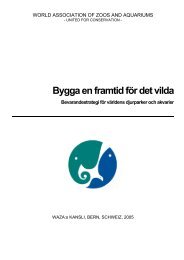Fighting Extinction - Waza
Fighting Extinction - Waza
Fighting Extinction - Waza
Create successful ePaper yourself
Turn your PDF publications into a flip-book with our unique Google optimized e-Paper software.
20 European Bison<br />
WAZA magazine Vol 13/2012<br />
»<br />
History of<br />
Species Recovery<br />
The European bison is special from<br />
a genetic point of view. Its gene pool<br />
is very small, which causes serious<br />
concerns regarding genetic management.<br />
The reason for such low<br />
genetic variability is that the species<br />
has passed through population bottlenecks<br />
more than once. In the 19th<br />
century only two populations of the<br />
species remained – one in Białowieża<br />
Primeval Forest (B. b. bonasus) and<br />
another in the Caucasus Mountains (B.<br />
b. caucasicus). Both populations were<br />
rather small, respectively numbering<br />
about 700 and 2,000 animals. A major<br />
bottleneck occurred during and after<br />
World War I. Both wild populations<br />
disappeared and only a few animals<br />
survived in captivity; by 1919 the European<br />
bison was considered Extinct<br />
in the Wild.<br />
In 1923, at the International Congress<br />
for Nature Protection in Paris, the<br />
Polish representative Jan Sztolcman<br />
delivered an “appeal on the necessity<br />
of saving the European bison”. It<br />
was agreed to create, as quickly as<br />
possible, an international society with<br />
the goal of saving the European bison.<br />
The Society for the Protection of the<br />
European Bison was established and<br />
Kurt Priemel, director of Frankfurt<br />
Zoo, was elected as its chairman.<br />
The Society’s first goal was to create<br />
a register of all living animals. Such<br />
a register, the European Bison Pedigree<br />
Book, was the first studbook for<br />
any wild species. After World War II<br />
the editorial office of the European<br />
Bison Pedigree Book was moved to<br />
Poland and the editorial work was<br />
conducted by Jan Żabiński, director of<br />
Warsaw Zoo. Since 1993 the editorial<br />
office of the European Bison Pedigree<br />
Book has been situated at Białowieza<br />
National Park.<br />
The inventory done in 1924 showed<br />
only 54 (29 males and 25 females)<br />
living European bison with proven purity.<br />
Those individuals, as well as their<br />
known ancestors, were listed in the<br />
first edition of the European Bison<br />
Pedigree Book where every animal<br />
was assigned a name and number.<br />
The last animals living by the end of<br />
1924 were mostly kept in estates of<br />
the European aristocracy – including<br />
seven at Pszczyna (Prince von Pless),<br />
ten at Woburn (Duke of Bedford), two<br />
at Boitzenburg (Count Arnim) and<br />
four at Scharbow (von Beyme). There<br />
were 28 animals in zoos (in Vienna,<br />
Amsterdam, Frankfurt, Berlin, Stockholm,<br />
London, Saint Petersburg and<br />
the reserve Askania Nova). A detailed<br />
pedigree analysis was first done by<br />
Slatis (1960). He found that all European<br />
bison (the whole population in<br />
1954) were descendants of a small<br />
group of ancestors. He identified 12<br />
unique genotypes as founders of the<br />
current population. Since then, in all<br />
subsequent analyses, this set of 12<br />
founders has been used (Olech 1999;<br />
Pucek et al. 2004). Up to now genes<br />
of all of these 12 animals are represented<br />
in the present population of<br />
the species.<br />
Small Gene Pool<br />
of the Species<br />
The facts that the lowest number of<br />
European bison was 54 individuals<br />
and that the gene pool of contemporary<br />
European bison originates from<br />
only 12 founders are often mixed<br />
up, and seem to have confused even<br />
people working in genetics. A thorough<br />
analysis of the pedigree of the<br />
54 animals alive in 1924 revealed<br />
that 28 animals at that time could<br />
be recognised as ancestors of the<br />
contemporary population. Seventeen<br />
of them were identified and<br />
their contribution explained 30 years<br />
later by Slatis (1960), but genes of<br />
the remaining 11 founders existed<br />
Fig. 2<br />
European bison with calves.<br />
© Janusz Sochacki<br />
only at the beginning of the recovery<br />
programme. A comparison of the genetic<br />
structure of the European bison<br />
populations in 1924 and 1954 showed<br />
that these 11 potential founders had<br />
a considerable representation in<br />
1924, equalling to 26.9% of the total<br />
gene pool (Olech 2009). Some of the<br />
potential founders died one or two<br />
years after the first inventory, but<br />
there were four founders represented<br />
by their progeny up to 1951. All those<br />
animals were kept in Woburn by the<br />
Duke of Bedford, who was very much<br />
involved in endangered species conservation.<br />
Among others he succeeded<br />
in breeding Père David’s deer, but<br />
probably did not hold the European<br />
bison in high regard. This was unfortunate<br />
because for a species with<br />
such a small gene pool, the survival of<br />
this group could have been important<br />
for improving genetic variability.<br />
Presently, the species is divided into<br />
two genetic lines: a pure lowland<br />
subspecies named Lowland line, and<br />
a second Lowland-Caucasian line<br />
with inclusion of genes from male no.<br />
100, the only one representing the<br />
Caucasian subspecies. The Lowland


